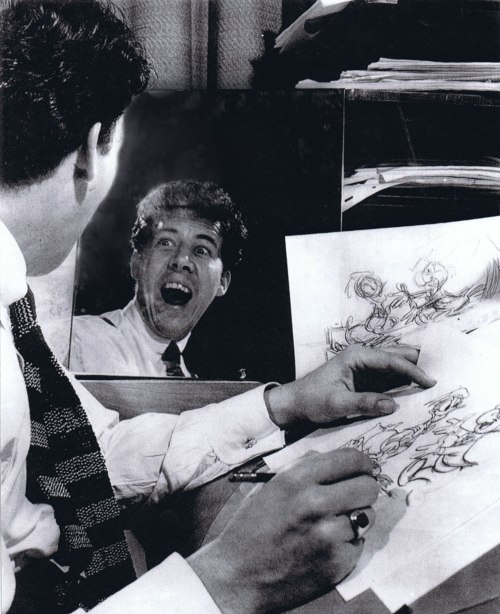
Suspended Animation # 211
Robert Fred Moore was born on September 7th, 1911. Unfortunately, while he was a natural animator, he also had a reputation as a “functioning” alcoholic. In Moore’s day alcoholism was regarded as a character flaw, not a disease, as it is generally regarded today.
His friend, animator Ward Kimball told me in a 1996 interview: “He’d start drinking around noon and by two o’clock he was fairly drunk and would swagger into a room asking, ‘Who would like a punch in the nose?’ Somebody complained that he was getting so drunk he couldn’t finish his animation on The Reluctant Dragon so I’d come back in the evenings and finish up some scenes for him.”
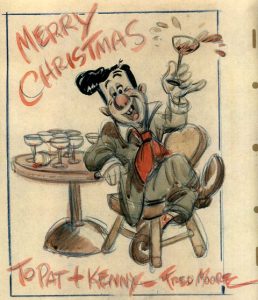 One of Moore’s last assistants, Joe Morrison, would tell the story of how Freddy would come in to work at 10:00am completely hungover. Joe would pour him a glass of Bourbon that Fred would drink out of a straw. “Ten minutes later he would say ‘Come on, Joe, let’s go’ and for the next three hours incredible animation just flowed from his hand. He then left for lunch to get another drink and wasn’t seen again until the next day.”
One of Moore’s last assistants, Joe Morrison, would tell the story of how Freddy would come in to work at 10:00am completely hungover. Joe would pour him a glass of Bourbon that Fred would drink out of a straw. “Ten minutes later he would say ‘Come on, Joe, let’s go’ and for the next three hours incredible animation just flowed from his hand. He then left for lunch to get another drink and wasn’t seen again until the next day.”
In fact, despite Moore’s talent, he was let go from the Disney Studios in 1946 as a “wake up call” to straighten up and sober up. Moore spent some time doing work at the Walter Lantz Studio but was re-hired by Disney in 1948.
Moore apparently did some freelancing outside of Disney between 1942 and 1943 for Swan Soap on a character called “Betty Lou” as well as some gag cartoons. Swan Soap sponsored a radio comedy titled “Tommy Riggs and Betty Lou” during the 1942-43 season. Betty Lou was a little girl who lived with Riggs, who was her uncle. “Betty Lou” was actually voiced by Riggs as well.
Because of his cockiness, his unparralleled natural drawing ability and his being one of Walt Disney’s favorites who got some choice assignments including Timothy the Mouse in Dumbo (1941), there was a great deal of jealousy towards him by some of the other artists which may account for some of the exaggerated tales about his death.
Fred Moore died in Los Angeles on November 23rd, 1952 at the age of 41. That incident has always been a source of some controversy with usually the story revolving around Moore being drunk and it somehow being a factor in his death.
There have been stories that while drunk, he stumbled and bumped his head on a car and it caused internal bleeding that led to his death. Another story insists that Moore was driving drunk and swerved and hit his head on the steering wheel. Yet another claims he was so drunk that he passed out in a driveway and a car ran over him.
One older animator told me that Moore died as a homeless drunk which is easily debunked because at the time of his death he was doing work on the mermaids and the Lost Boys in the film Peter Pan (1953) so he was fully employed.
Over the years, bizarre legends have sprung up surrounding Moore’s unfortunate and untimely death.
Gus Jeckyl was Moore’s assistant at Disney. According to him, Moore was getting out of his parked car and a drunk driver sideswiped him. (Moore was sober at the time.) He was taken to the hospital, but he had no insurance or money to pay for the treatment. The doctors told him that they wanted to do more tests, but that would cost money.
They would give him the day to try to line up cash, but if he couldn’t find any, they would have to discharge him the next morning. Moore and Jeckyl got on the phone and called all of Fred’s old friends at Disney to ask to borrow money to help pay for his treatment, but everyone turned their back on him. Jeckyl said that one after another of Fred’s friends told him “Freddie just wants the money to get drunk again …”
The hospital finally discharged Moore when it became clear he had no way to pay his bills. He was sent home in a taxi, and died on his front doorstep with his house key in his hand from internal bleeding.
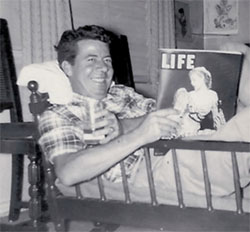 The next day, one major animator who had refused to give Fred a dime for his hospital bill moaned and cried loudly over the “great loss”. In between sobs, he made a point of whispering to everyone, “You know of course that Freddie was drunk when he got in the accident …” It was a lie designed to make the whole thing Fred’s fault, and deflect any responsibility from Fred’s “old friends” for turning their back on him.
The next day, one major animator who had refused to give Fred a dime for his hospital bill moaned and cried loudly over the “great loss”. In between sobs, he made a point of whispering to everyone, “You know of course that Freddie was drunk when he got in the accident …” It was a lie designed to make the whole thing Fred’s fault, and deflect any responsibility from Fred’s “old friends” for turning their back on him.
That same animator later saved the stub of one of Fred’s drawing pencils in the belief that it was magic and one day he might need the help of that magic on an assignment.
Certainly, this is a tragic story and one carrying an aura of validity because of Jeckyl’s association with Moore. Unfortunately, like the dozens of other stories about Moore’s demise, it isn’t true. For one thing, Moore was a 839 animation union member with full health benefits and for another St. Joseph’s would never turn out a seriously injured individual. Yet all these false stories persist because no one seems to know the true story or wished to minimize Moore.
A few years ago, Joe Campana ferreted out the actual truth through public records and according to those records Fred Moore actually died on Sunday, November 2rd, 1952 at 4:15 pm, at St. Joseph’s Hospital in Burbank (the same hospital where Walt would pass away in 1966).
His death was a result of a head injury from a vehicle-on-vehicle collision the previous evening at Big Tujunga Canyon near the Angeles National Forest. Moore was not at the wheel at the time of the accident; his second wife Virginia who was 35 was driving and sustained minor injuries that were treated at St. Joseph’s Hospital.
Fred’s two daughters from his first wife (also named Virginia), were Melinda and Suzanne and were not in the car. Fred died a day after the car accident from a cerebral hemorrhage caused by a concussion as well as massive trauma to the chest.
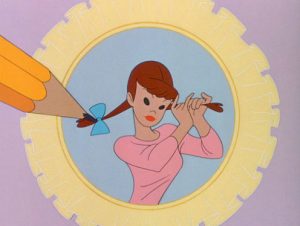 The Moores were returning from a visit to Disney animation director Jack Kinney’s house on Saturday evening November 22nd, 1952 to watch a college football game. Kinney had directed the All The Cats Join In segment on which Moore had personally animated the entire sequence from when the girl answers the telephone and then quickly showers and dresses, through to her scene putting on lipstick in front of her mirror.
The Moores were returning from a visit to Disney animation director Jack Kinney’s house on Saturday evening November 22nd, 1952 to watch a college football game. Kinney had directed the All The Cats Join In segment on which Moore had personally animated the entire sequence from when the girl answers the telephone and then quickly showers and dresses, through to her scene putting on lipstick in front of her mirror.
In fact, Joe confirmed that the USC-UCLA game had been played that day. The time of the accident and the location of the accident also seem to support this story. It is apparent that the Moores got disoriented while driving home and when they attempted to turn around to head in the opposite direction, the collision occurred.
The driver of the other car, Roy Sowles, died many years ago, and attempts to locate the other passenger, Jesse Sowles (probably Sowles’ son), who sustained minor injuries have not been successful.
Joe located a contemporary newspaper account of the accident as well as Moore’s death certificate listing the cause as “cerebral hemorrhage” and that an autopsy was performed.
Moore was posthumously inducted as an official Disney Legend in 1995. He had earlier received the animation industry’s Winsor McCay Award in 1983. His work is still studied today and he is buried in Forest Lawn Hollywood Hills overlooking the Disney Studio.
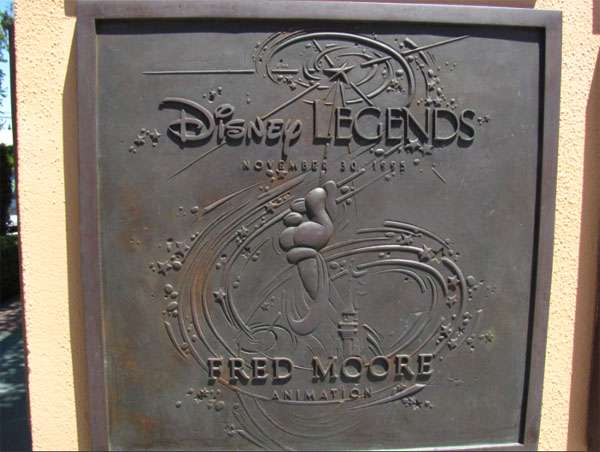


 Jim Korkis is an internationally respected animation historian who in recent years has devoted his attention to the many worlds of Disney. He was a columnist for a variety of animation magazines. With his former writing partner, John Cawley, he authored several animation related books including The Encyclopedia of Cartoon Superstars, How to Create Animation, Cartoon Confidential and Get Animated’s Animation Art Buyer’s Guide. He taught animation classes at the Disney Institute in Florida as well as instructing classes on acting and animation history for Disney Feature Animation: Florida.
Jim Korkis is an internationally respected animation historian who in recent years has devoted his attention to the many worlds of Disney. He was a columnist for a variety of animation magazines. With his former writing partner, John Cawley, he authored several animation related books including The Encyclopedia of Cartoon Superstars, How to Create Animation, Cartoon Confidential and Get Animated’s Animation Art Buyer’s Guide. He taught animation classes at the Disney Institute in Florida as well as instructing classes on acting and animation history for Disney Feature Animation: Florida.




















































Excellent piece of research. I love when false narratives are debunked.
It seems lots of false narratives have surrounded Disney for years and that people actually get angry if you try to point them in the right direction. What a pity when the real stories are far more interesting.
Great read, really interesting information.
Nice piece, Jim. I too wrote about this, on my Blackwing blog, in 2006:
http://blackwingdiaries.blogspot.com/2006/08/on-death-truth-and-animation-history.html?m=0
The facts will also be in my forthcoming book on Moore, and hopefully put to rest(no pun intended), to these old myths.
Did you complete a book on Moore? If so, where could I find it. I was always told Fred Moore was a cousin of my father’s, but I have never been able to determine if that is true. We all were in Illinois, not sure of Robert Fred Moore’s family background.
Fred Moore
Bloomington, IL
” A lie can travel halfway around the world while the truth is putting on its shoes.”
Really interesting seeing you debunk all these false narratives that are essentially tall tales. I suspect Moore had quite a personality if people would make up stories about him to make his death seem fantastic.
One mystery not related to animation but funny animal comics is Ellis Holly Chambers. It’d be a miracle if someone would find out merely when he was born or when he died. All we know of him is what the late Howie Post told Milton Knight, and apparently being a heroin addict, a cannabis affectionado, and a “psychotic” (did Howie mean mental or psychopathic?) he sounds like one of the most characteristic types to ever draw cute funny animals. And someone you’d love the work of but want to avoid in real life.
Howard was using the term “psycho….” generically, as nonprofessionals did up until recently. From what he said, in these more enlightened times, folks would be more likely to define Chambers as a sociopath. Howard said Chambers could walk out with a bar stool and stare down the bartender. Intimidating, manipulating, on the edge.
You mean he could get away with taking the barstool simply by looking the bartender in the eyes? Dang, he sounds… complex, to say the least.
Apparently sociopaths can live “dangerous” lifestyles which can explain his drug habits, and taking into account his lack of empathy it’s a little creepy thinking what his plans for Howie could’ve been. Maybe he was trying to get Howie to get used to working for him but then barely pay him so he could get drug money. Or maybe something even more sinister. Him stealing Howie’s story but then paying him good money to work for him, was that some kind of lure? A lot of questions in my mind now that my suspicions of him being a sociopath based on some of his comics are confirmed.
Thanks very much for the clarification. Any more stories Howie had about him besides the barstool thing?
He seemed to have covered it all in that interview. In it, he might have described Chambers as he did to me: very handsome, which added to the mystique.
Chambers sounds like an all-around mysterious figure. Being a very handsome drug-addicted sociopath adds some creepiness to his works. His character almost sounds a little like a “likable” horror movie villain. There are so many questions you can ask about him. He drew funny animals very well and many of his works had a sense of adventure and a cartoon energy to them but also at times they just got… bizarre. He sure knew how to draw an animated style despite not working in animation. Clearly he had some affinity for the cartoon form and his own cartoon style ranged from underground to illustrated quality. I really wonder what happened to him, and I also wonder how potential recreational drawings compared to what got published. But alas more info about him and original art are very unlikely to ever come up. Thanks again for the clarification.
Chambers is very interesting. The stuff Post said in the Comic Book Artist Interview in 1999 was kind of terrifying; he talked about Chambers not having a needle so cutting his arm open with a razor blade on his drawing table. I’ve looked for more biographical information about Chambers for years and can find nothing.
Chambers definitely comes across as very interesting and characteristic. And yeah, the Post interview is the only biographical information you’ll find about Chambers on the Internet. It’s a shame as there’s so many questions about Chambers I have, yet we don’t even know his birth and death dates.
I will always love Freddie Moore, he is still my favourite Mickey Mouse artist bringing him to life. It is a shame that some people just can’t see the good in people and when that happens maybe they should take a good look at themselves. RIP Freddie I will forever remember you for being my Mickey.
The animator who kept FM’s pencil stub taped to the window was Ollie Johnston, wasn’t it?
I am not at all an animation fanatic even though I’ve written about historic illustration but was reading Gabler’s Disney bio and wanted to learn more about Moore. Having lived and worked in L.A. for 25 years, I am not at all surprised when sad, unfortunate, or even downright evil things occur in people’s lives there but I knew there would be more to his death and I suspect to his alcoholism as well. Thank you so much to the author of this for setting the record straight on this by actually seeking out documented truth. I also know how incredibly dishonest people can be – after 65 years on the planet involved in many places and a few different fields I can say that the well off and well educated are FAR greater at thievery and criminal activity than good and decent working people so those trying to “co-opt” the creative ideas of others I’ve witnessed far too many times. Jealous losers in a world dominated by GENUINELY hard working people, even apparently in the animation industry, taking advantage Moore’s sadly premature death.